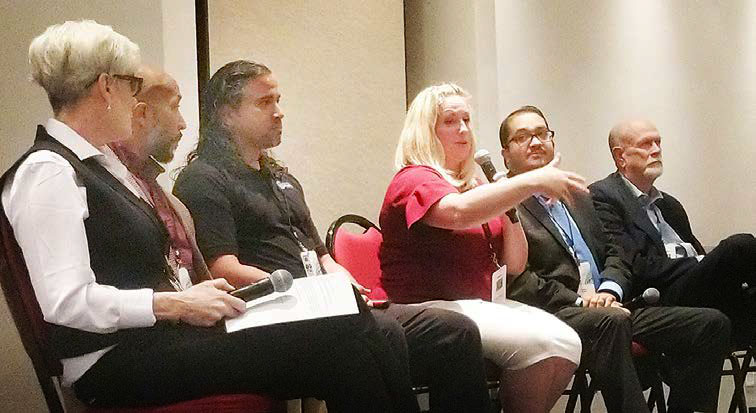Brice Wallace
Utah’s demographics are changing, and a group of government officials and others want to see those changes reflected in government contracting.
Getting a diverse mix of businesses involved in government work can benefit not just those businesses but also local, state and federal agencies, speakers said at the recent PTAC Symposium in Sandy.{mprestriction ids="1,3"}
Chuck Spence, director of the Procurement Technical Assistance Center (PTAC) at the Governor’s Office of Economic Opportunity, noted that diversity in Utah’s workforce currently stands at nearly 20 percent but is expected to reach 40 percent in the year 2060.
Nubia Pena, senior advisor on equity and opportunity and director of the Utah Division of Multicultural Affairs at the Utah Governor’s Office, said a recent U.S. Census Bureau survey indicated that about 17 percent of Utah small businesses reported large negative impacts from the COVID-19 pandemic, including some closing their doors, and the ones most impacted were those who are historically the most underrepresented.
That, combined with the nation’s attention on social injustice issues “shined the light on the gaps that existed long before COVID-19 was ever a concern,” she said.
“There is an opportunity here from the last two years to learn about how we can, in fact, do better and close gaps and disparities for everyone in our state,” Pena said.
Not all people in Utah can claim a narrative of success, leaving government with a role in growing pathways and access to opportunities “for people who call this great state their home,” she said.
Currently, half of Utahns identify themselves as women and 25 percent identify as racially or ethnically diverse, she said. By 2045, one of three will identify as multiracial. But the figures are smaller when it comes to business ownership in the state and even smaller still among businesses that get government contracts.
Organizations and companies rise when they diversify, she said.
“That is why we need to see genuine action and have top-down, bottom-up leadership buy-in that supply diversity programs work, and we need to not only discuss the benefits of diversity and inclusion, but we need to create tangible plans for how we as leaders strategically open doors to more vendors that represent the changing demographics of our state and our customer base,” Pena said.
However, speakers throughout the event spoke about barriers to entry for minority and other businesses. Daniel Tuuatu, business resource liaison at the Pacific Island Chamber of Commerce, said much of the chamber’s work is educating business owners about opportunities and resources available to help them.
“A lot of times, we just don’t know,” Tuuatu said. “A lot of these small businesses just don’t know what the opportunities are, and if they do know that it exists, they don’t know how to take advantage of it.”
Thomas Gerke, regional manager for PTAC, listed several organizations that can help guide business owners through the procurement process. He and others stressed, however, that being part of a sought-after group helps the chances of landing a government contract but businesses still need to be able to demonstrate their ability to fulfill that contract.
“I just think that those designations — 8(a), service disabled, veteran-owned small businesses, etc. — make it easier for a contracting officer to award to you, but you still have to be competitive, and you still have to show capability and capacity,” Gerke said. “It’s really hard to explain to a small-business owner that the government really isn’t obligated to help you. You have to be able to help the government.”
Alysha Caldwell, source development specialist at the Hill Air Force Base Small Business Office, echoed that sentiment, stressing that businesses seeking a government contract must be capable and responsible.
“Just because you’re an 8(a), just because you’re a woman-owned small business, just because you’re a service disabled veteran-owned small business, doesn’t mean that we’re going to throw a contract at you,” Caldwell said.
“Come to us with a solution” to help the government, she said. “Don’t come to me and say, ‘I’m a woman-owned small business; what can you do for me?’ That’s not going to help.”
Christopher Jennings, chief procurement officer for Salt Lake City, said diversity and inclusion means having a level playing field for businesses seeking government work.
“I believe that there are some institutional disadvantages just in the way the government operates,” Jennings said. “Those who have experience with us tend to have a leg up. Also, there could be an element of intimidation as well — not everyone works in a neo-Gothic architecture building that’s really big and tall and scary. Or if you’re not used to working with the strange rules of the world of procurement, it can seem quite arbitrary, the way we operate.”
Cody Neville, procurement center representative for the U.S. Small Business Administration, noted that diversity, equity and inclusion can help many businesses, but the government also can benefit from having a wider range of contributors. Agencies and organizations can learn from individuals or businesses that show “maybe a different way of approaching a problem and having a different solution that they may have not have thought of on their own,” he said.
“So, diversity to me also drives value, it drives good return on investment, it drives good opportunities, it drives good collaboration, and when we have diversity, all of those things also seem to shove to the table.”
Small businesses of all types can get involved in government contracting; they don’t need to be prime contractors, he said.
“The federal government is very aware that this country runs because of small businesses. It’s not the large primes,” Neville said. “Of course, they have their place and we need them, but the country runs on the backbone of small business, so they are trying to increase those dollars that go to those types of businesses.”{/mprestriction}








